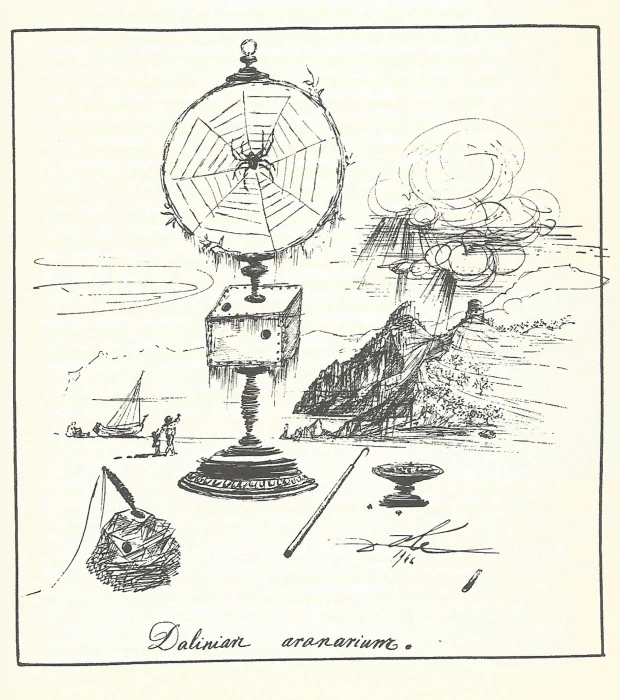Salvador Dalí was a super weird wildly eccentric person. Ten seconds of Google will net you dozens of articles outlining the better-than-fiction details of his life. He thought he was the reincarnation of his dead brother. He paid for his restaurant bills with doodles on the backs of checks, knowing that the doodle was worth more than the bill. Dalí once collaborated will Disney. He liked butts and orgies. Then there was that time he was on the gameshow What’s My Line? and answered yes to every question.


There’s one thing missing from all the lists. I mean really, why does no one mention it? In 1948, Dalí published a book titled 50 Secrets of Magic Craftsmanship (you can get it here). It’s all about how to be a great painter – just like Dalí himself – and it’s literally 50 ways to accomplish it. The book is a stream of verbose egotistical rantings and it’s AMAZING. Here’s one of my favorite quotes:
“Compare yourself… to a kind of dromedary masticating visions which constantly make you drool with satisfaction.”
This is the beginning of a long rant comparing the artist to a camel with a massive hump that houses the brain and describes how images are processed through the mouth that is now also the stomach and…
You can also read about slightly more serious things like color palettes and studio settings in this book, but there’s one secret in particular that has stuck with me since I first read the book years ago: how to make an aranearium.
What the Heck is an Aranearium?
I’m still trying to figure out if aranearium is a made up word. A similar word, aranearum, is plural for aranea, which is Latin for spider web or cob web. However, looking up aranearium just leads to information about Dalí and images of spiders. Made up or not, we could guess that an aranearium is an enclosure for spiders and/or spider webs.
That’s exactly what Dalí tells us to make in Secret 15 from his book.
Secret 15 – The Secret for Constructing an Aranearium
I’ve boiled this process down into ten simple steps, but make no mistake – this is a process. It assumes that you will be able to procure your own spider. Be sure to pick one you like because this little one will be your friend and assistant for quite some time. Oh, and you have to train it. Dalí assures us that this is all well worth it. Using the aranearium will not only make you drool, but weep!


Step 1: Make a Hoop
Get a slender olive branch and bend it into the most perfectly circular hoop you can manage. Leave four or five leaves around the outside for your spider’s enjoyment.
Step 2: Make a Base
Secure your perfectly round hoop to four-foot long pine wood pole attached to a solid base. We don’t want our drool-worthy spider hoop to fall over!
Step 3: Add a Spider Box
Place a small, perfectly cube-shaped box made of very green pine at the bottom of the hoop. It should have one hole in the top and a hole in one side. This will be your spider’s nest.
Step 4: Get the Box Wet
Moisten your spider box, put some dirt in it, and let it dry in the sun.
Step 5: Make the Aranearium Fancy
Place a little ball of amber on the box. Amber is “very sympathetic” to both artist and spider, according to Dalí. You’ll use it to magnetize the tip of your wand, which is used to train and direct your spider.
Step 6: Set the Table
Place a small bowl next to the amber ball. This is where you will keep dead flies for your spider when you are training and feeding it.
Step 7: Train Your Spider
Place your spider friend in its new home. Using your magic wand charged by the amber ball, put a dead fly on the end. Use your wand to direct your spider where to go. If spidey does good, spidey gets treat! Simple, right?


Step 8: Weave a Web
This is the hardest part! You have to get your spider to weave its web “exactly within the circle of your aranearium.” You’ll need to keep bringing the spider to the hoop and directing it with your fly-laden, amber-charged, magic wand until starts to weave, so keep lots of flies and patience in your little bowl.
Step 9: Reward Your Spider!
You and spidey have been working really hard, so give your eight-legged friend some encouragement and extra flies. This will make it want to stick around.
Step 10: One Aranearium Isn’t Enough
Build at least four more araneariums because every knows a good studio has at least five.


What Now?
Now that you have your five araneariums, you’re probably wondering what to do with them. Never fear, it’s all explained in Secret #16 – The Secret of the Retrospective Utilization of Araneariums! It’s doesn’t get easier, but if you want to achieve drooling and weeping we have to learn how to use the aranearium in part two!
